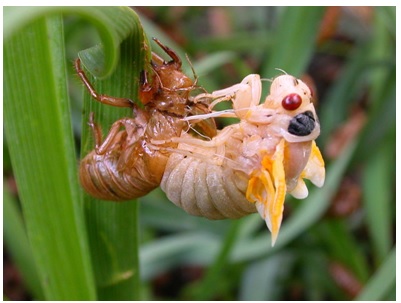Difference Between Molting and Metamorphosis
Table of Contents
Molting vs Metamorphosis
Molting and metamorphosis are two important events in the life cycle of animals that show some difference between them. Molting and metamorphosis are very common in insects. These two phenomena are controlled by the two classes of hormones; ecdysteroids and juvenile hormones (JHs). Molting is not found in vertebrates. However, some vertebrates like amphibians show metamorphosis during their life cycle. In this article, difference between molting and metamorphosis will be explained via discussing individual events.
What is Molting?
All the insects have a hardened exoskeleton made up of chitin. This exoskeleton protects the inside organs and also prevents water loss. At the same time, it restricts the growth of insects. To avoid this problem, insects have to shed their exoskeleton several times during their life time. However, before they shed the exoskeleton, they always have a new developing exoskeleton underneath the old one. The entire process starting from the development of new exoskeleton to casting off the old exoskeleton is called molting. In addition, casting off the old exoskeleton is known as ecdysis. The stages between the periods of molting are called instars.
Molting cycle consists of sequence of events that ultimately build a new, larger exoskeleton within the old one. These events are triggered by the hormone called ecdysone, which is secreted by a pair of glands in the thorax of insects. While secreting ecdysone, another pair of glands near the brain secretes juvenile hormone, which inhibits the metamorphosis. Hence, it causes an insect to remain larva stage after ecdysis rather than transforming into pupil stage.

Cicada molting
What is Metamorphosis?
Metamorphosis is the process of which arthropods undergo changes in their form between the immature stages and adult during their growth. In many arthropods, these changes are minor, including the changes in size and color or pattern. However, most distinguishable changes can be seen in insects during their growth from larvae to adult. Metamorphosis is mainly controlled by the endocrine system of arthropods. Metamorphosis is suppressed by juvenile hormone, which secretes during the molting. However, when decreasing the hormone concentration of blood, it increases the possibility of metamorphosis. There are two types of metamorphosis; complete and incomplete metamorphosis. Insects with complete metamorphosis have four stages in their life cycle, namely; egg, larva, pupa, and adult. Each of this stage is very distinguishable. This can be seen in insects like moths and butterflies. Incomplete metamorphosis has three life stages; egg, nymph and adult. Nymph stage is more similar to adult form with the exception of color, size, and the lack of wings. Examples for insects with incomplete metamorphosis include mites, aphids, bugs, cockroaches etc.

Complete metamorphosis
What is the difference between Molting and Metamorphosis?
• Molting is the process of developing a new exoskeleton and casting off the old exoskeleton. Metamorphosis is the change in form between immature stages to adult stage.
• Molting does not involve the changes in life cycle stages, but metamorphosis does.
• Juvenile hormone triggers the molting whereas it suppresses the metamorphosis.
Image Courtesy:
ncG1vNJzZmivp6x7pbXFn5yrnZ6YsqOx07CcnqZemLyue8OinZ%2Bdopq7pLGMm5ytr5Wau265zqWroqaXYq6vsIyvqmallamurrvRqZ%2Boq5mofA%3D%3D